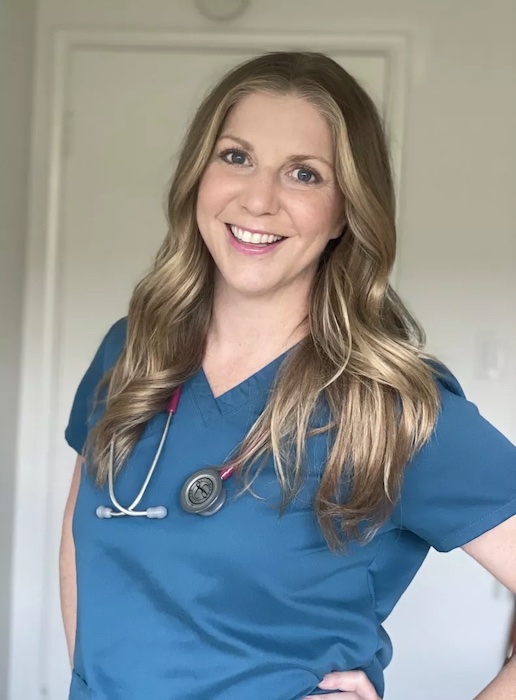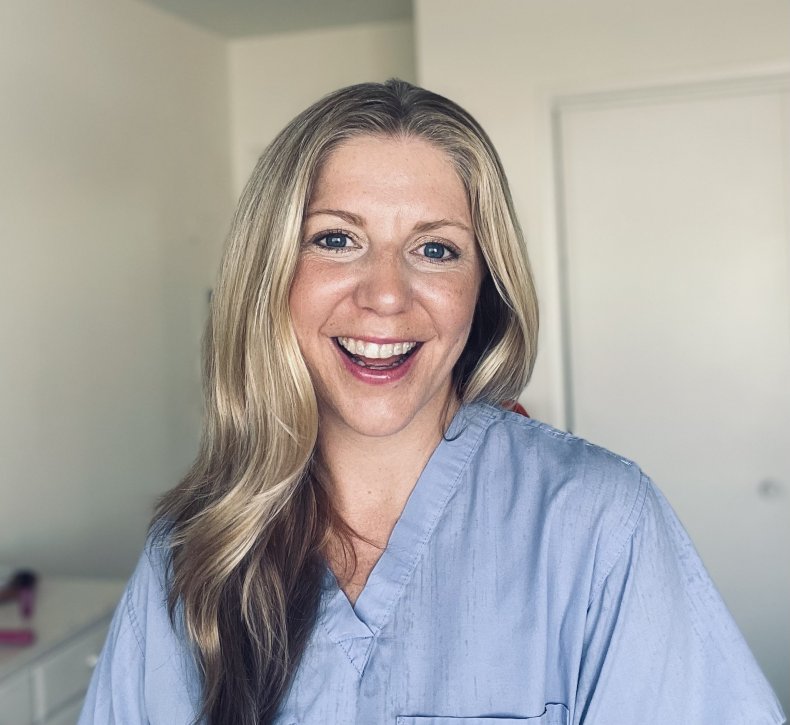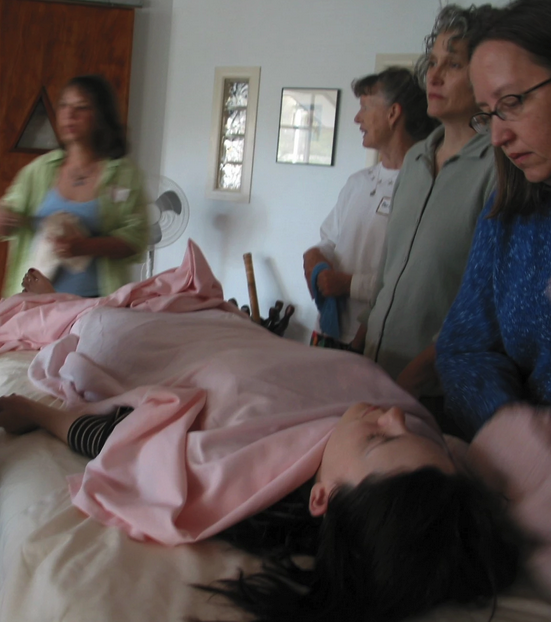
Many people might not like talking about end-of-life care or death until they’re faced with it themselves, but this hospice nurse wants to remove the taboo from the topic and educate people instead.
As an intensive care unit (ICU) nurse for over a decade, Julie McFadden, 40, focused on keeping patients alive, but when she made the switch to hospice care eight years ago, her attention turned towards making people feel comfortable as they neared the end.
McFadden, from California, regularly talks about the realities of hospice care, and what happens when a patient opts for medical aid while dying, on social media. She told Newsweek: “My main point is to make everyone a little less afraid of death. I want to change the way we look at death and dying.”
Medical aid in dying (also referred to as death with dignity, physician-assisted death, and aid in dying) is the prescribing of life-ending medication to terminally ill adults with less than six months to live, who are mentally and physically capable of ingesting the medication independently.
At present, only 10 states and the District of Columbia permit this process, but there is growing support elsewhere. A survey of over 1,000 people in 2023 by Susquehanna Polling and Research concluded that 79 percent of people with a disability agree that medical aid in dying should be legal for terminally ill adults who wish to die peacefully.
States where it’s permitted include Colorado, California, Washington, Hawaii, Maine, Montana, Oregon, and Vermont. Legislation is also being considered in Massachusetts, New York and Pennsylvania.
How the End of Life Drug Is Administered
As a hospice nurse in California, where a bill was passed to permit death with dignity in 2015, and became effective from June 2016, McFadden has assisted many patients who wanted to die on their terms.
She believes that there is real beauty in someone being able to have full autonomy over their death and choosing when they go, but she knows it’s a polarizing issue.
“People have to remember that not everyone has the same beliefs and I think it’s a beautiful thing that someone gets to have control over,” McFadden told Newsweek. “It’s powerful to witness someone be so alert, say goodbye to their loved ones, have their loved ones watch them take this drink and then die, but still be willing to be there to support them.
“I think most people in the U.S. have no idea that this law even exists, and even when I give very descriptive explanations of what the law is, what it means, what the criteria is, there’s still people who think I’m just overdosing patients with morphine.”
In order to acquire the medication, an individual’s request must be approved by two doctors, they have to undergo a psychological evaluation to ensure they aren’t suicidal, and doctors have to confirm that the person is capable of making their own decisions. Patients with certain conditions do not qualify, including those with dementia.
If approved, the person must take the medication themselves, and they can have family, friends, and hospice staff present if they wish.
Since June 2016, in California 3,766 death with dignity prescriptions have been written, and 2,422 deaths registered. To protect the confidentiality of any individual who makes this decision, death certificates usually note an underlying illness as the cause of death.
McFadden continued: “There are a few drugs mixed in, it’s taken all at once and the initial drugs kick in very quickly, within three to seven minutes. This person who ingested this drug will fall asleep or basically go unconscious. I say fall asleep just so people can picture what it looks like, but they’re unconscious.
“Then, the body is digesting and taking in the rest of the drugs that are also in that mixture, which will eventually stop the heart. It’s a general sedative and then they take two different cardiac drugs to stop the heart.
“They have a change in skin color and changes to their breathing, in what we call the actively dying phase, which is the last phase of life.”

People Have A Lot of Misconceptions
Regardless of whether you’re in a state that permits physician-assisted death or not, dying isn’t regularly talked about in a positive way.
One of the reasons why McFadden wants to have a more open conversation about it is to remove any prior misconceptions that people might have and educate them on what really happens.
“I have not seen anyone show signs of pain, but people are always concerned about that,” she said. “In general, if you’ve done this for a long time, if you’ve been in the healthcare system and work as a nurse or by someone’s bedside, you know what a body in pain looks like, it’s very obvious.
“A person who is unconscious and can’t verbally say they’re in pain will show you with their body language. Most people that have taken this medication who I have witnessed did not show those signs. I witness it day in, day out, but it’s pretty miraculous to see how our bodies, without even trying, know how to die. They’re built to do it.
“People get really angry and think I’m trying to hurt people. I always want to educate people around this topic, because the main thing people don’t want is for their loved ones to suffer at the end of life.”
As an ICU nurse formerly, McFadden explained to Newsweek that she was trained to keep patients alive, and they “didn’t have conversations about death early enough.” Despite patients being near death, they were kept alive through machinery for weeks or months, before ultimately dying on the ward.
Many of the country’s biggest medical associations are conflicted by death with dignity, with some choosing to endorse it, and others speaking against it. The American Public Health Association, and the American Medical Student Association are among the bodies to endorse it, but it has been publicly opposed by the American Medical Association and the American College of Physicians.

Talking Openly About Death
In 2021, McFadden set up her TikTok account (@hospicenursejulie) to speak openly with her followers about death and answer any questions people might have. Many of her videos have gone viral with millions of views, and while she does get a lot of positive feedback, there is also plenty of negativity.
There are people who wholly disagree with her advocacy for death with dignity as they claim she is playing God, or that she’s promoting suicide. But by having an open conversation, the 40-year-old hopes to make people less fearful of dying.
Speaking to Newsweek, she said: “Most of my audience is general public, that’s why I don’t talk like I’m speaking to other nurses or physicians. I talk like I’m speaking to my families who I talk to in everyday life. I think death just isn’t talked about, or it’s not explained well.
“I’m seeing so many times that people who are willing to have difficult conversations about their own death, who are willing to say they’re afraid to die, those patients who were willing to ask me those things and talk to me about death, had a much more peaceful death.”
Complete Article ↪HERE↩!






